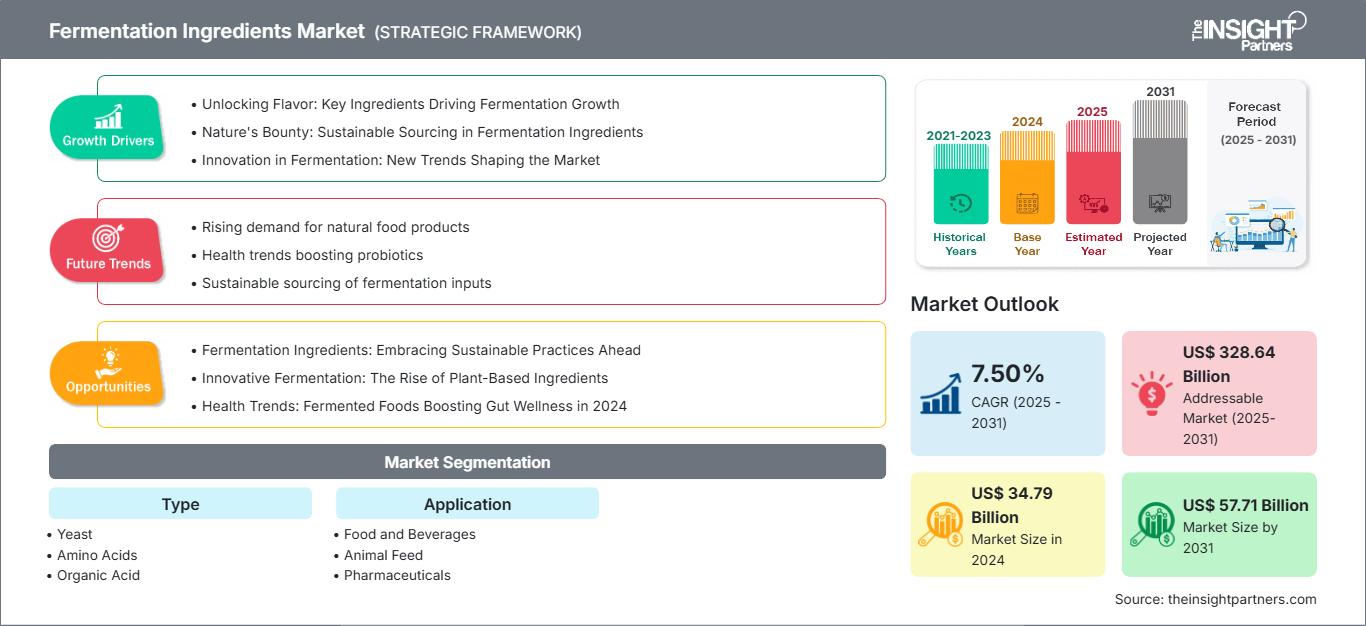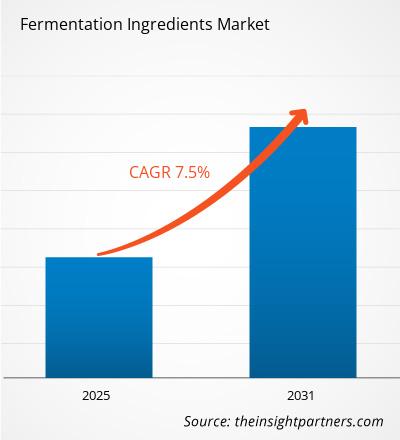Si prevede che il mercato degli ingredienti per la fermentazione registrerà un CAGR del 7,50% dal 2025 al 2031, con una dimensione del mercato in espansione da 34,79 miliardi di dollari nel 2024 a 57,71 miliardi di dollari entro il 2031.
Il rapporto è suddiviso per tipologia (lievito, aminoacidi, acidi organici, vitamine, enzimi) e analizza ulteriormente il mercato in base all'applicazione (alimenti e bevande, mangimi, prodotti farmaceutici, prodotti per la cura della persona). Per ciascuno di questi segmenti chiave viene fornita una ripartizione completa a livello globale, regionale e nazionale.
Il rapporto include dimensioni e previsioni di mercato per tutti i segmenti, con valori espressi in USD . Fornisce inoltre statistiche chiave sullo stato attuale del mercato dei principali attori, oltre ad approfondimenti sulle tendenze di mercato prevalenti e sulle opportunità emergenti.
Scopo del rapporto
Il rapporto "Fermentation Ingredients Market" di The Insight Partners mira a descrivere il panorama attuale e la crescita futura, i principali fattori trainanti, le sfide e le opportunità. Questo fornirà spunti di riflessione a diversi stakeholder aziendali, tra cui:
- Fornitori/produttori di tecnologia: per comprendere le dinamiche di mercato in evoluzione e conoscere le potenziali opportunità di crescita, consentendo loro di prendere decisioni strategiche informate.
- Investitori: per condurre un'analisi completa delle tendenze in merito al tasso di crescita del mercato, alle proiezioni finanziarie del mercato e alle opportunità esistenti lungo la catena del valore.
- Enti di regolamentazione: regolamentano le politiche e le attività di controllo sul mercato con l'obiettivo di ridurre al minimo gli abusi, preservare la fiducia degli investitori e sostenere l'integrità e la stabilità del mercato.
Segmentazione del mercato degli ingredienti per la fermentazione
Tipo
- Lievito
- Aminoacidi
- Acido organico
- Vitamine
- Enzimi
Applicazione
- Cibo e bevande
- Mangimi per animali
- Prodotti farmaceutici
- Prodotti per la cura della persona
Otterrai la personalizzazione gratuita di qualsiasi report, incluse parti di questo report, analisi a livello nazionale, pacchetto dati Excel e potrai usufruire di fantastiche offerte e sconti per start-up e università.
Mercato degli ingredienti per la fermentazione: approfondimenti strategici

- Scopri le principali tendenze di mercato di questo rapporto.Questo campione GRATUITO includerà analisi dei dati, che spaziano dalle tendenze di mercato alle stime e alle previsioni.
Fattori trainanti della crescita del mercato degli ingredienti per la fermentazione
- Sbloccare il sapore: ingredienti chiave che guidano la crescita della fermentazione
- I doni della natura: approvvigionamento sostenibile degli ingredienti per la fermentazione
- Innovazione nella fermentazione: nuove tendenze che modellano il mercato
Tendenze future del mercato degli ingredienti per la fermentazione
- Crescente domanda di prodotti alimentari naturali
- Tendenze in ambito sanitario che promuovono i probiotici
- Approvvigionamento sostenibile di input per la fermentazione
Opportunità di mercato per gli ingredienti di fermentazione
- Ingredienti per la fermentazione: adottare pratiche sostenibili in futuro
- Fermentazione innovativa: l'ascesa degli ingredienti vegetali
- Tendenze in salute: gli alimenti fermentati migliorano il benessere intestinale nel 2024
Approfondimenti regionali sul mercato degli ingredienti per la fermentazione
Le tendenze e i fattori regionali che hanno influenzato il mercato degli ingredienti per la fermentazione durante il periodo di previsione sono stati ampiamente spiegati dagli analisti di The Insight Partners. Questa sezione illustra anche i segmenti e la distribuzione geografica del mercato degli ingredienti per la fermentazione in Nord America, Europa, Asia-Pacifico, Medio Oriente e Africa, America Meridionale e Centrale.
Ambito del rapporto di mercato sugli ingredienti per la fermentazione
| Attributo del report | Dettagli |
|---|---|
| Dimensioni del mercato nel 2024 | 34,79 miliardi di dollari USA |
| Dimensioni del mercato entro il 2031 | 57,71 miliardi di dollari USA |
| CAGR globale (2025 - 2031) | 7,50% |
| Dati storici | 2021-2023 |
| Periodo di previsione | 2025-2031 |
| Segmenti coperti | Per tipo
|
| Regioni e paesi coperti | America del Nord
|
| Leader di mercato e profili aziendali chiave |
|
Densità degli attori del mercato degli ingredienti per la fermentazione: comprendere il suo impatto sulle dinamiche aziendali
Il mercato degli ingredienti per la fermentazione è in rapida crescita, trainato dalla crescente domanda da parte degli utenti finali, dovuta a fattori quali l'evoluzione delle preferenze dei consumatori, i progressi tecnologici e una maggiore consapevolezza dei benefici del prodotto. Con l'aumento della domanda, le aziende stanno ampliando la propria offerta, innovando per soddisfare le esigenze dei consumatori e sfruttando le tendenze emergenti, alimentando ulteriormente la crescita del mercato.

- Ottieni una panoramica dei principali attori del mercato degli ingredienti per la fermentazione
Punti di forza chiave
- Copertura completa: il rapporto copre in modo completo l'analisi di prodotti, servizi, tipologie e utenti finali del mercato degli ingredienti per la fermentazione, fornendo un panorama olistico.
- Analisi degli esperti: il rapporto è redatto sulla base della conoscenza approfondita di esperti e analisti del settore.
- Informazioni aggiornate: il rapporto garantisce la pertinenza aziendale grazie alla copertura delle informazioni più recenti e delle tendenze dei dati.
- Opzioni di personalizzazione: questo report può essere personalizzato per soddisfare le esigenze specifiche del cliente e adattarsi in modo appropriato alle strategie aziendali.
Il rapporto di ricerca sul mercato degli ingredienti per la fermentazione può quindi contribuire a tracciare un percorso di decodificazione e comprensione dello scenario del settore e delle prospettive di crescita. Sebbene possano esserci alcune valide preoccupazioni, i vantaggi complessivi di questo rapporto tendono a superare gli svantaggi.
- Analisi storica (2 anni), anno base, previsione (7 anni) con CAGR
- Analisi PEST e SWOT
- Valore/volume delle dimensioni del mercato - Globale, Regionale, Nazionale
- Industria e panorama competitivo
- Set di dati Excel
Report recenti
Testimonianze
Motivo dell'acquisto
- Processo decisionale informato
- Comprensione delle dinamiche di mercato
- Analisi competitiva
- Analisi dei clienti
- Previsioni di mercato
- Mitigazione del rischio
- Pianificazione strategica
- Giustificazione degli investimenti
- Identificazione dei mercati emergenti
- Miglioramento delle strategie di marketing
- Aumento dell'efficienza operativa
- Allineamento alle tendenze normative




















 Ottieni un campione gratuito per - Mercato degli ingredienti per la fermentazione
Ottieni un campione gratuito per - Mercato degli ingredienti per la fermentazione